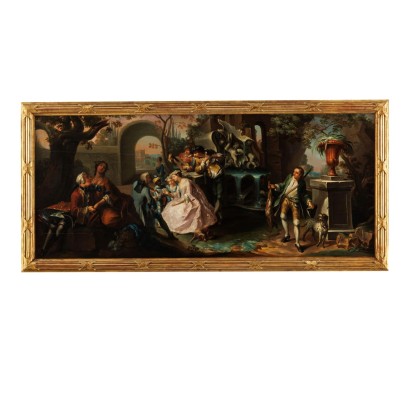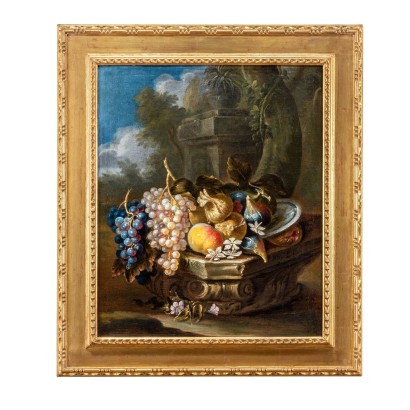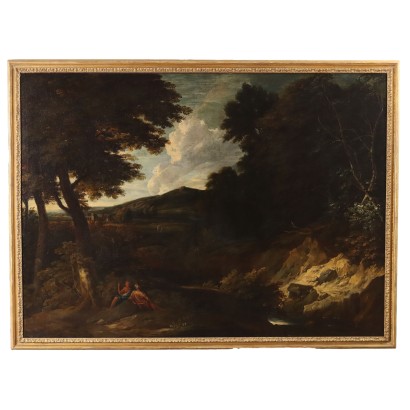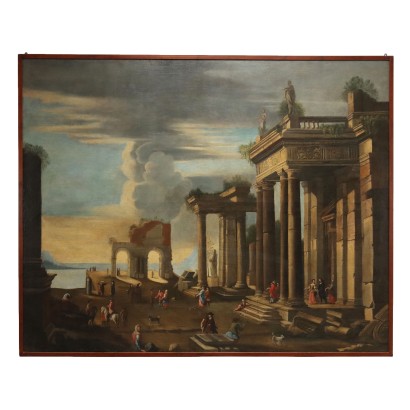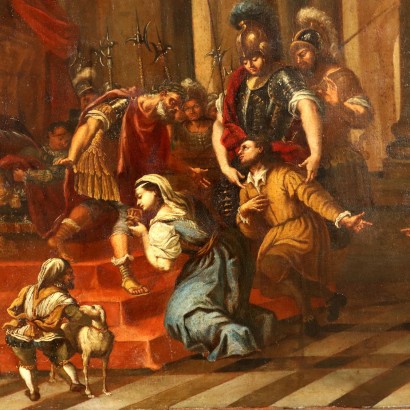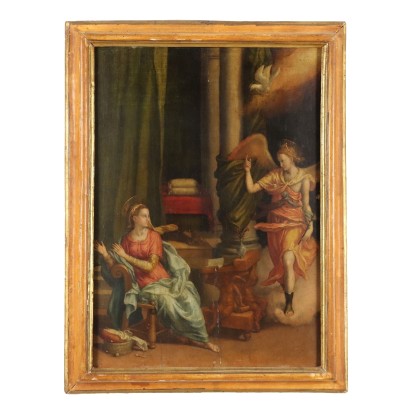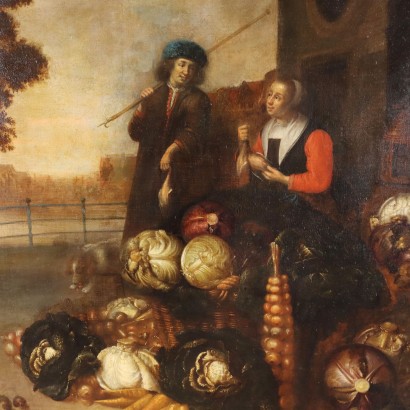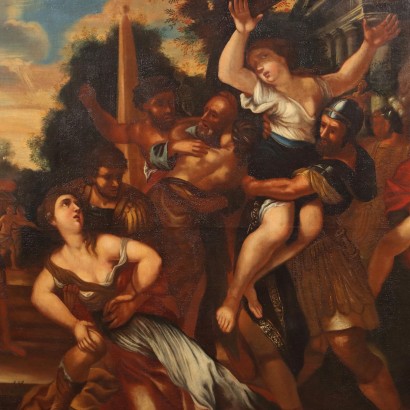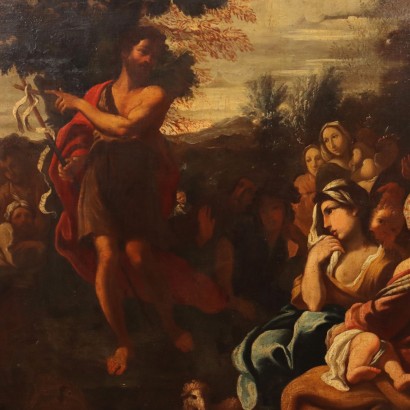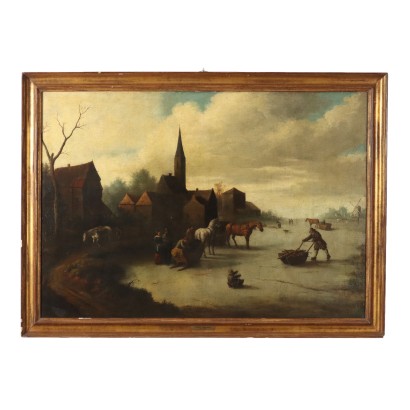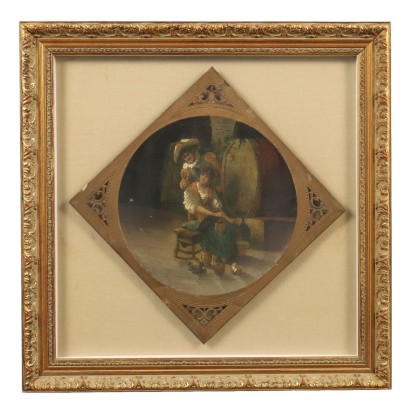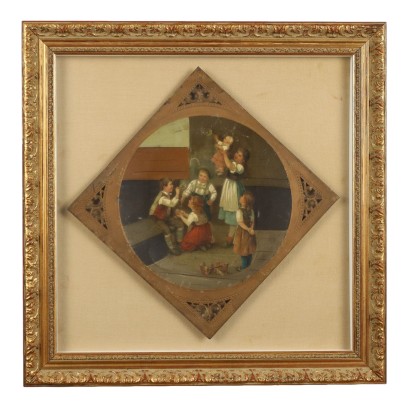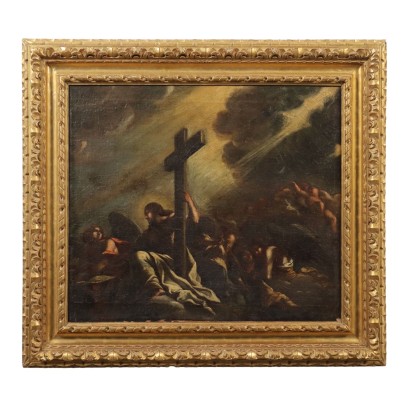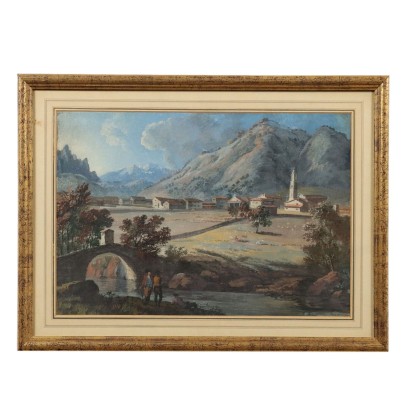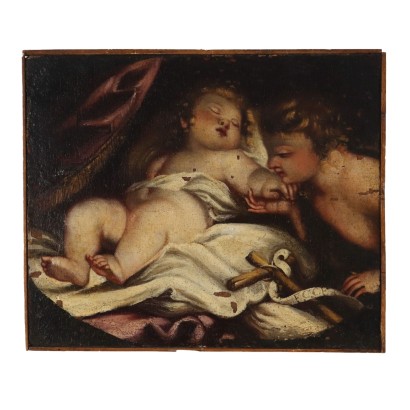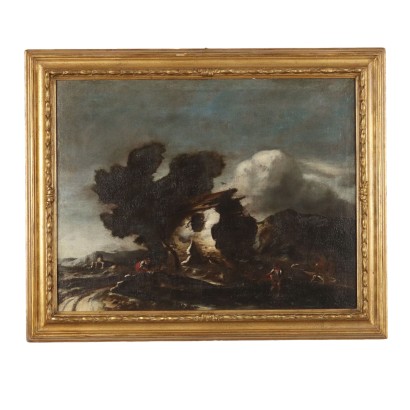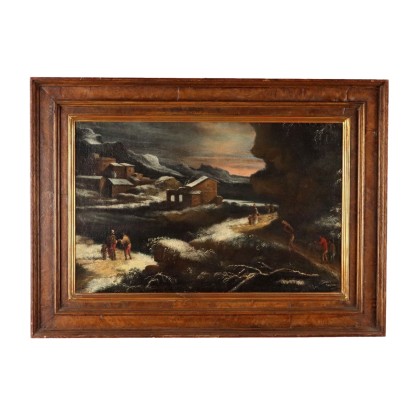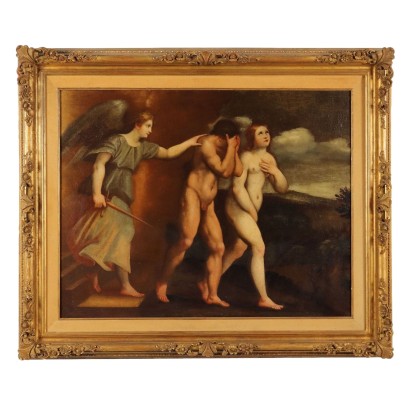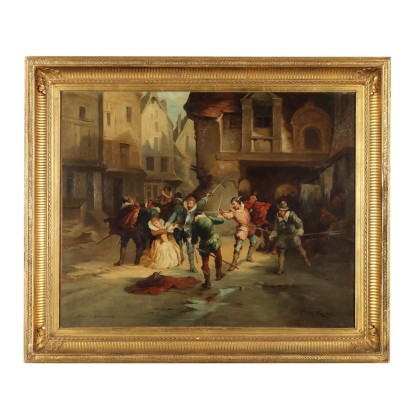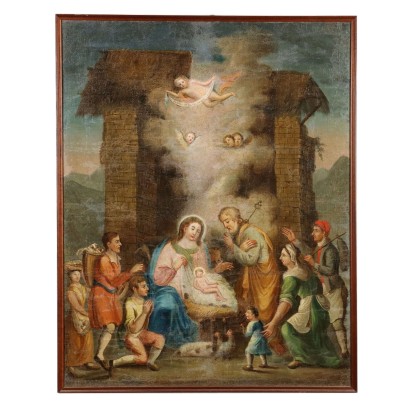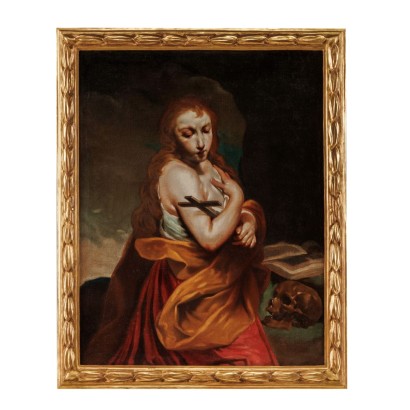Antique Painting Gallant Scene French School XVIII Century - French school. Mid 18th century
Features
French school. Mid 18th century
Artwork title: Festa galante nel parco
Artistic school: French School
Age: 18th Century / 1701 - 1800
Subject: Genre Scenes
Artistic technique: Painting
Technical specification: Oil on Board
Description : Festa galante nel parco
Oil on wooden board. French School. Mid-18th century. The scene depicts a party in a park enclosed by walls with arched openings that open onto the countryside, and decorated on the right with an amphora on a small column and in the center, behind the figures, with a gushing fountain, with statues of cherubs and shells. Two couples of richly dressed ladies and gentlemen are gallantly entertaining each other, surrounded by servants; one of the men is playing the violin, crouched in front of his lady who, flanked by the damsel, follows the melody on the score held by the black man at her side, while two musicians accompany the playing with the flute and a mandolin; the other couple, in an attitude of intimate dialogue, listens on the left, while on the right the hunter returning from the hunt also observes the scene. The painting is presented in a period frame.
Product Condition:
Product in good condition, shows small signs of wear. We try to present the real state as fully as possible with photos. If some details are not clear from the photos, what is reported in the description will prevail.
Frame Size (cm):
Height: 61
Width: 131
Depth: 4
Artwork dimensions (cm):
Height: 52
Width: 123
Additional Information
Notes historical bibliographic
In the scene, the rich dress of the lady in the center stands out in particular, characterized by the large rear folds falling from the shoulders to create a cloak. This dress corresponds to what was called "robe à la Watteau", from the name of the French painter Antoine Watteau who was the first to portray ladies wearing this model. Antoine Watteau (1684 -1721), French painter considered one of the most influential French exponents of Rococo painting, was the precursor of the pictorial genre of gallant scenes, a genre that developed in France from the end of the 17th century and continued throughout the following century. The gallant scenes could be considered as the aristocratic version of the genre scenes: characterized by music, dances, pleasant conversations between ladies and gentlemen surrounded by servants, they tended to exalt the costumes, the fashionable clothes, the environments of the upper class, transmitting a a sort of detachment from real times and places, projecting the spectator into an almost theatrical atmosphere, made up of gestures, glances, colors and stage lights. Furthermore, Watteau, together with the cycles of the Fêtes galantes, also stood out for those inspired by the theatre, absorbing the passion for the scenes and characters of this environment from Claude Gillot, the Parisian painter of theatrical subjects in whose workshop Watteau trained between 1702 and 1707/1708. The panel of the painting presented here is also decorated on the back with a "chinoiserie" style motif, leading us to assume that this side must also be visible, for example acting as a cover for an opening piece of furniture. Also on the back is the stamp of Pietro Accorsi (1891 -1982), the great Turin antiquarian and collector who, thanks to an exceptional artistic intuition, in seventy years of work recovered thousands of dismembered and dispersed works of art and established himself as a consultant to collectors, dealers and art institutions of all nationalities.Artistic school: French School
Age: 18th Century / 1701 - 1800
18th Century / 1701 - 1800Subject: Genre Scenes
Artistic technique: Painting
La pittura è l'arte che consiste nell'applicare dei pigmenti a un supporto come la carta, la tela, la seta, la ceramica, il legno, il vetro o un muro. Essendo i pigmenti essenzialmente solidi, è necessario utilizzare un legante, che li porti a uno stadio liquido, più fluido o più denso, e un collante, che permetta l'adesione duratura al supporto. Chi dipinge è detto pittore o pittrice. Il risultato è un'immagine che, a seconda delle intenzioni dell'autore, esprime la sua percezione del mondo o una libera associazione di forme o un qualsiasi altro significato, a seconda della sua creatività, del suo gusto estetico e di quello della società di cui fa parte.Technical specification: Oil on Board
Other customers have searched:
Pittura antica, artisti italiani, pittura olio su tela, arte 800, pittura antica, arte novecento, oggetti d'arte, ritratto di signora, dipinto animali, quadro paesaggio montano, dipinto olio su tela, dipinto antico, dipinti natura morta, quadro antico, quadro del '600, pittori italiani quadri olio su tela paesaggi, paesaggio marino dipinto, paesaggio invernale dipinto, paesaggio autunnale dipinto, dipinto di paesaggio, arte antica, quadro religioso..
Se sei un appassionato d'arte, non perderti i nostri approfondimenti sul Blog Arte Di Mano in Mano e su FineArt by Di Mano in Mano - Arte:
Leggi di più
Ecco alcuni tra i principali articoli:
Vedute
Falsi nell'arte antica
Un messaggio di fiducia per ripartire
La potenza espressiva dell'arte figurativa etiope
Breve Storia del Collezionismo
Giorgio Upiglio, maestro dei libri d'artista
Matthias Withoos detto "Calzetta bianca"
San Rocco pensaci tu - Classic Monday
Dai un'occhiata alle nostre rubriche di divulgazione sull'arte:
Epoche
Lavorazioni e tecniche
Mostre ed Eventi
Protagonisti
Se sei appassionato di pittura antica, con tutta probabilità gusterai le schede di questi stupendi quadri:
"Dio parla a Noè dopo il diluvio", Jacopo da Ponte, detto il Bassano, seconda metà XVI secolo
Crocifissione, maestro della misericordia dell'accademia, terzo quarto del XIV secolo
Erminia incontra i pastori, Camillo Gavassetti, Seconda metà anni Venti del XVII Secolo
Eroine dell'antichità, Francesco Conti, XVIII secolo
Hieronymus III Francken, La Negazione di Pietro, XVII secolo
Jefte e la figlia, Girolamo Forabosco e aiuti, XVII secolo
L'Accademia di Platone, piccolo arazzo, fine XVII - inizio XVIII secolo
Maddalena e San Giovanni Battista
Natura Morta, Bartolomeo Arbotori, XVIII secolo
Sacra Famiglia con San Giovannino, Bartolomeo Ramenghi, scuola di, prima metà XVI secolo
Testa Femminile, Andrea del Sarto, ambito di, post 1522
Uva, fichi, melagrana e pesche su un capitello - Maximilian Pfeiler, primo quarto XVIII secolo
Sapevi che l'arte può essere anche un ottimo investimento (e non solo per grandi portafogli)?
L'Arte tra Collezionismo e Investimento
FineArt: Arte come investimento
Leggi di più
Ecco alcuni tra i principali articoli:Vedute
Falsi nell'arte antica
Un messaggio di fiducia per ripartire
La potenza espressiva dell'arte figurativa etiope
Breve Storia del Collezionismo
Giorgio Upiglio, maestro dei libri d'artista
Matthias Withoos detto "Calzetta bianca"
San Rocco pensaci tu - Classic Monday
Dai un'occhiata alle nostre rubriche di divulgazione sull'arte:
Epoche
Lavorazioni e tecniche
Mostre ed Eventi
Protagonisti
Se sei appassionato di pittura antica, con tutta probabilità gusterai le schede di questi stupendi quadri:
"Dio parla a Noè dopo il diluvio", Jacopo da Ponte, detto il Bassano, seconda metà XVI secolo
Crocifissione, maestro della misericordia dell'accademia, terzo quarto del XIV secolo
Erminia incontra i pastori, Camillo Gavassetti, Seconda metà anni Venti del XVII Secolo
Eroine dell'antichità, Francesco Conti, XVIII secolo
Hieronymus III Francken, La Negazione di Pietro, XVII secolo
Jefte e la figlia, Girolamo Forabosco e aiuti, XVII secolo
L'Accademia di Platone, piccolo arazzo, fine XVII - inizio XVIII secolo
Maddalena e San Giovanni Battista
Natura Morta, Bartolomeo Arbotori, XVIII secolo
Sacra Famiglia con San Giovannino, Bartolomeo Ramenghi, scuola di, prima metà XVI secolo
Testa Femminile, Andrea del Sarto, ambito di, post 1522
Uva, fichi, melagrana e pesche su un capitello - Maximilian Pfeiler, primo quarto XVIII secolo
Sapevi che l'arte può essere anche un ottimo investimento (e non solo per grandi portafogli)?
L'Arte tra Collezionismo e Investimento
FineArt: Arte come investimento
Product availability
The product can be seen at Milan
Immediate availability
Ready for delivery within 2 working days from ordering the product.



